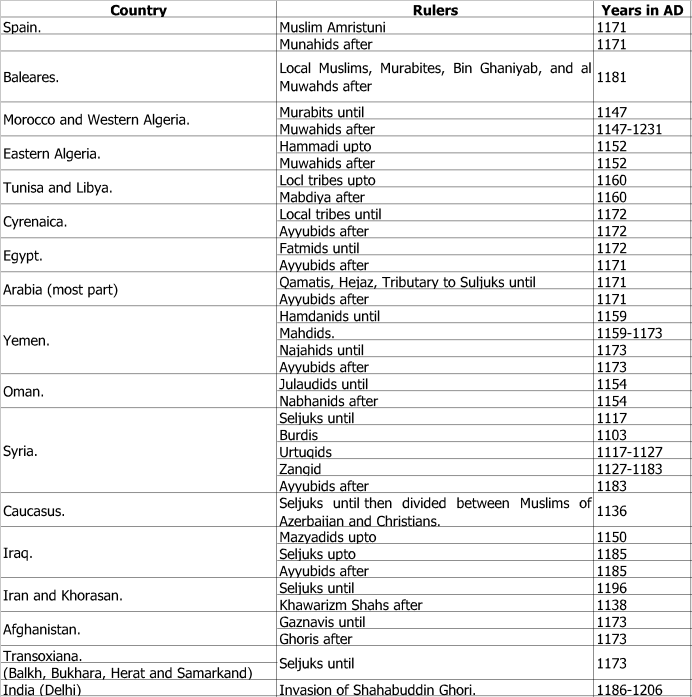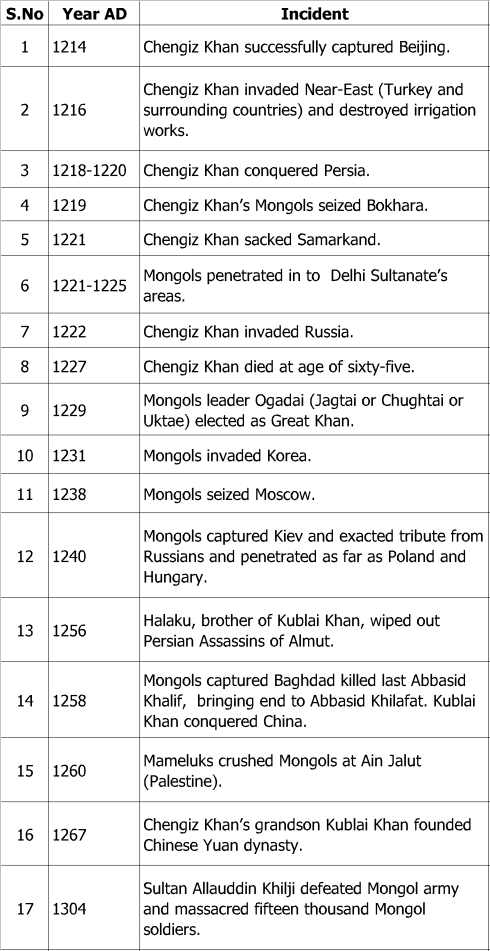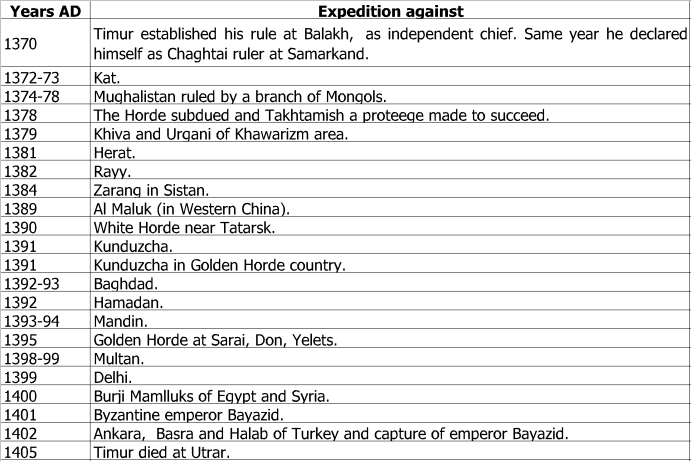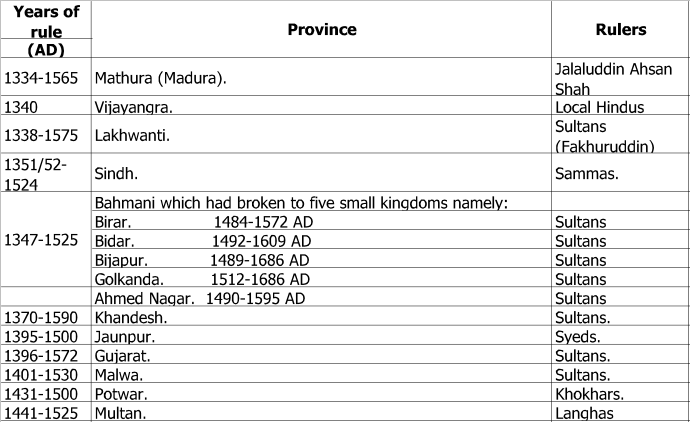







Muhammad Bin Tughlaq and Feroz Tughlaq’s invasion of Sindh and fall of Delhi Sultanate : 1330 to 1400 AD was caused by drought. Droughts are connected with cold weather, low rainfall in the Central Asia, Iran and deserts from Morocco to Baluchistan. It is a phenomenon that occurs through out the world. In some cases drought occurs with a time lag of a century or two, but in general it happens world over.
The figure below shows the climatic changes from 850-1950 AD.
When temperatures fall, there is less rainfall, less snow melt in Himalayas, lower water level in the Indus and its tributaries, low level of water in irrigation canals, less area under cultivation to support population which declines with deterioration of area under cultivation, resentment against the government, rebellions and internal wars and famines and deaths, reducing population matching the available resources. Usually there are foreign invasions and occupation of fertile river valleys during droughts.
See Climatic Graph 850-1950 AD
From the graph it is clear that before 900 AD there was drought. From 800-1200 was climatic optimum with low temperature around 1150 AD. Climate again became optimum around 1200 AD, but there was depression after 1200 AD to about 1300 AD. Climate improved a little after 1300 but only temporary upto 1350 AD only to deteriorate fast upto 1400 AD as above graph shows.
Around 1150 AD there started drought in the world, which affected sub-tropic areas of the world more than temperate zones or tropics and we have a glaring example of change of Muslim dynasties in all Desert areas from Morocco to Iran and Afghanistan. Table below gives the changes in rulers from about 1150 AD.

Climate in the Central Asia from 1200 to 1300 AD.
Climatic graph of world 1200 to 1300 AD.
Dry climate made its first start in the Central Asia in the last thirty years of twelfth century and under the ledership of Shahabuddin Ghori, after some battles, he established them-selves at Kanuj (India) in 1186 AD. It was simultaneously that Kurd leder Salahuddin Ayubi conquered Egypt from Fatmids. The dry spell continued and more severely in the Central Asia and Mongolia.
The climate in Sindh was optimum around 1200 AD, but became cold with drought world over from 1200 AD onwards, the consequences of which were, that Ghoris lost their hold over Central Asia and Afghanistan in 1215 AD to Khawarizm Shah, who in turn was defeated by Mongols. Ghori’s successors in India were Slave kings starting with Qutubuddin and on his death by Altatmish and Nasiruddin Qabacha. The latter in turn was defeated by the former in 1228 AD. Mongols raided Delhi Sultanate almost every year, but their most important and devasting raids were in years; 1221, 1241, 1246, 1260, 1291, 1298, 1304, 1346, 1351, 1358, 1399, 1429, 1520 and 1524/25 AD. Incidentally both Timur and Babar were Mongols. The chronology of important events relating of Mongol conquests and devastations Asia and Europe in the thirteenth century is as under:

All these events are impact of drought in Central Asia and the efforts of tribes of area to capture new lands for food, shelter and security, which invariably led to devastation of settled and civilised people of irrigated river valleys and fertile lands. Severe drought in the Central Asia also caused destruction of Tsin Dynasty in China by Mongols.
The above invasions or raids of Mongols on Delhi Sultanate’s territories laid the southern Punjab a waste land and depopulated. Gypsies of Europe are considered to be immigrants from the southern Punjab (Multan-Bahawalpur) during era of Mongol invasions in the thirteenth century. Delhi Sultanate maintained Uch and Multan as military cantonments to stop Mongols from reaching Delhi. Besides gypsies, other people migrated to northern and the eastern Punjab and upper Sindh, where their descendants still speak Seraiki language.
Southern Sindh remained independent from 1236-1297 AD, when it was conquered by Allauddin’s general. It tried to become independent in 1333 AD. In 1351 AD, Soomras gave shelter to Taghi, a rebel of Muhammad Tughlaq and the latter attacked Sindh, but died at Sondha, before defeating Soomras, who were soon replaced by Sammas.
The climatic changes from 1200 to 1350 are shown by graph below:
Climatic graph 1300-1350 AD (No.6)
The temperature curve shows that Climatic Optimum in Sindh had reached maximum in 1200 AD. From 1200 AD to 1250 mild drought occurred during which period Sindh was attacked by Qabacha and Uch, Bakhar and Sehwan were ceded but Soomras become independent during rule of Razia (1236-1239 AD). Their rule had continued uninterrupted until conquered by Allauddin’s troops in 1297 AD.
The period 1300-1500 AD was arid in many areas of the world. For Sindh, it may have been slightly fair upto 1330 AD but aridity kept increasing very fast from about 1330 to 1400 AD. The drought of fourteenth century in some parts of South-Asia brought all troubles for Muhammad Tughlaq from 1330-1351 AD and collapse of his empire under Feroz Tughlaq, who had to face worsening aridity through out his rule of thirty seven years, leading to rebellions throughout the possession. The temperature curve 1350-1400 AD shows abrupt fall of temperatures by about 1°C and it led to low rainfall and low production and consequently rebellions in various areas of Delhi Sultanate and finally collapse of the empire, which then disintegrated in small kingdoms. The maps Nos.1, and 2 show the rebellion in South Asia and map No.3 and 4 show the 4 maps fall of Delhi Sultanate to small kingdoms by 1400 AD and further deterioration by 1441 AD.
Climate of Sindh 1350-1400 AD and developments.
Climatic graph 1350-1400 and 1400-1500 AD (No.7)
There was cold and drought and in one hundred fifty years from 1350 to 1500 AD, temperatures came down with low rainfall and low productivity. The climatic effect on Sindh was that Jam Banbhniyo Samma, tried to capture some areas of Delhi Sultanate in the Multan Sarkar and also south in Gujarat. He was subdued not militarily but politically through his spiritual guide Makhdoom Jehania of Uch and Sindh played no further significant role until death of Feroz Shah Tughlaq in 1388 AD. The South-Asia witnessed a number of famine years in the fourteenth century. Irrigation system in Sindh appears to have dwindled and to make living, even local saints in Sindh had become nomadic pastorals in the fourteenth century. One effect of drought after 1330 AD in Sindh was rise of Sammas, who within twenty years were able to replace Soomras and make whole Sindh free from the rule of Delhi.
Drought led to rise of Timur Lane.
Drought in the Central Asia in the mid fourteenth century weakened power of Mongols, who fought against each other and finally, it was Timur, him-self a Mongol, who subdued rival factions and established his empire. His expeditions for 32 years are listed in table below.

Timur’s expedition against Delhi in 1399 AD was not for conquest, but for booty. He massacred population of Delhi for some days to collect wealth, accumulated over two centuries expeditions by Delhi Sultans, their noblemen, generals and administrators. Timurlane attacked other territories, as his predecessors and ancestors, the Mongols had done before him, to collect wealth and settle his people and warlords at Samarkand, a beautiful city built from spoils of other nations. Map No.5 gives Timurs empire.
Drought and break up of Delhi Sultanate.
The effect of this cold and drought after 1350 AD was break up of Delhi Sultanate into small principalities. By 1440 AD temperature reached the lowest since 1351 AD. Temperatures gradually rose from 1440 AD, but yet were lower than those around 1200 AD. Under unfavourable temperatures, the rulers from local stock who knew irrigated agriculture very well, utilised the Indus waters through the canals and water wheels, to maintain production and off set effects of drought by maintaining irrigation system efficiently. Desertification in Thar and Kohistann almost to the present level must have continued. Samma’s attempt to harness waters of rainfed rivers in Johi Taluka and settling people on them was an attempt to combat drought.
Sindh probably did not face drought severely, as both Soomras and Sammas were able to face Tughlaq invasions in 1350-1368 AD, and Sammas had expanded their territories, but troubles for Soomras may have been caused by climatic fluctuation around 1300-1400 AD. This gave gradual rise of Sammas to power and increased desert conditions in Thar and Kohistan. Due to climatic change, Soomras lost power in 1351/2 AD. In Sindh the climate remained dry, but Sammas reduced impact by irrigation. After 1450 AD climate started improving and irrigation system improved. There were dry periods under Sammas after 1370 to 1400, but then climate was at least not too unfavourable for about a century and half and then dry periods started. It may have been that effects of adverse climate were set aside by management of irrigation. Some Samma canals had survived upto opening of Sukkur Barrage, when they were merged in new canal system.
On account of drought, break up of Delhi Sultanate of Allauddin, which he had conquered by 1315 AD, and covered nearly the whole of India, was almost complete by 1400 AD. The break away kingdom and their rulers and period of their rule, are shown in table below:

Though boundaries of these kingdoms changed and petty wars occurred, but in general there was peace between various states.
Drought causes rise of Sammas and fall of Soomras.
Due to drought, in Delhi Sultanate, which controlled major towns Bakhar and Sehwan on the river Indus in Sindh and also Lahri Bander the seaport, production of food and feed decreased and Sammas raised rebellion in Sindh under Jam Unar and Qaiser Rumi, who killed Malik Rattan, the Jagirdar of Sehwan and Jam Unar under title Malik Feroz became ruler of Upper Sindh. He had 1800 mounted cavaliers, who helped him to rise to power. Knowing this the governor of Multan Amadul-Malik Sartez laid siege to Sehwan and had Qaiser’s men eliminated, but Jam Unar reached his tribe safely in the interior of Sindh. Simultaneously there were rebellion at Daulatabad by Malik Hushand, Shahu Afghan at Multan, Hindus in Sanam, Samana, Kaithan and Kuhram. Fakhruddin rebelled in Bengal and rebellion started in Western Telegu, Tilingana, Thandi and Mandam (northern Malabar). Soon 1333-1338 AD Jalaluddin Ahsan Shah governor of Malabar rebelled and established his independent Sultanate of Madura. Mongol chief Haljaun helped by a Hindu Amir rebelled at Lahore, but was defeated. The Delhi Sultanate of Muhammad Tughlaq therefore had started breaking up due to drought, though contemporary historians had not visualised it.
Muhammad Bin Tughlaq’s expedition against Thatta.
In 1347 AD, Taghi raised rebellion in Gujarat and having been defeated by Muhammad Tughlaq’s armies, fled to Sindh for protection under Soomras of Thatta. Muhammad Tughlaq therefore made preparation for invasion of Sindh and called troops and boats from Multan, Uch, Depalpur, by the river and land and even Mongols under Altun Bahador came from Farghana via Bolan Pass, but on March 1351 AD, he died at Sonda probably by poisoning. Historian Ziauddin Barni states that unless Mahmud Tughlaq had died not even one of his under takers would have survived. His death was followed by coronation of Feroz Tughlaq at Sonda, renewed Soomra attacks on Imperial troops and Mongols too joined Soomras.
Feroze Tughhlaq’s invasion of Thatta.
Sammas under Jam Unar defeated Soomras in 1351/52 and Hamir Dodo the last Soomra ruler fled to Multan to seek protection of Delhi. Jam Banbhniyo son of Jam Unar and his uncle Jam Juno ruled Sindh jointly. Banbhniyo attacked Delhi Sultanate territories in Multan and Gujarat and had Hamir Soomro killed. These actions of his, brought Feroz Shah’s invasion of Sindh in 1365-1368 AD.
The Tughlaq expedition consisted of 90,000 cavalry, 480 elephants and 5000 boats, he but was defeated by Banbhiniyos 20,000 cavalry and 400,000 foot soldiers and fled to Gujarat. He organised a second expedition against Thatta and could not capture it militarily but called for Makhdoom Jehania of Uch Murshid of Sammas and under his influence Banbhniyo surrendered to Delhi in autumn 1368 AD, almost after three years military operations.
From 1400-1550 AD, climate improved. Sammas ruled Sindh during the period. They improved irrigation. Some of their canals were operative upto 1932 AD and were merged in Sukkur, Kotri and Gudu barrages atleast in part. River level was low due to mild drought and lifting water by Persian wheels was the main source of irrigation, as historical records prove.
Sources.
This article has been extracted from author’s “Climatic changes and their impact on history of Sindh” ready to go to press and would be released in early 2005. The other source is authors “Chronological Dictionary of Sindh” (1983). Another source is authors “Five thousand years of History of Irrigation in Sindh” (1993) and revised edition entitled “Six thousand years of irrigation in Sindh” is expected to come out in early 2005. Maps and climatic graphs are also from the same sources.
By
M. H. Panhwar
DROUGHT, THE CAUSE OF INVASIONS OF THATTA BY MUHAMMAD AND FEROZE TUGHLAQS AND FALL OF DELHI SULTANATE 1330-1400 AD

| Tribute |
| Resting Place |
| Books |
| Articles on Sindh |
| Technical Atricles |
| Activities |
| Photo Gallery |
| Videos |